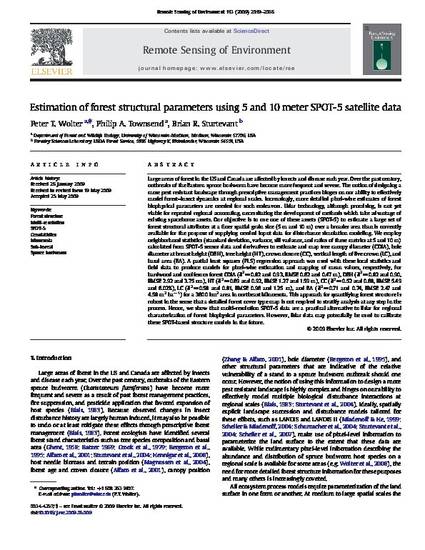
Article
Estimation of forest structural parameters using 5 and 10 meter SPOT-5 satellite data
Remote Sensing of Environment
(2009)
Abstract
Large areas of forest in the US and Canada are affected by insects and disease each year. Over the past century, outbreaks of the Eastern spruce budworm have become more frequent and severe. The notion of designing a more pest resistant landscape through prescriptive management practices hinges on our ability to effectively model forest–insect dynamics at regional scales. Increasingly, more detailed pixel-wise estimates of forest biophysical parameters are needed for such endeavors. Lidar technology, although promising, is not yet viable for repeated regional accounting, necessitating the development of methods which take advantage of existing spaceborne assets. Our objective is to use one of these assets (SPOT-5) to estimate a large set of forest structural attributes at a finer spatial grain size (5 m and 10 m) over a broader area than is currently available for the purpose of supplying needed input data for disturbance simulation modeling. We employ neighborhood statistics (standard deviation, variance, sill variance, and ratios of these metrics at 5 and 10 m) calculated from SPOT-5 sensor data and derivatives to estimate and map tree canopy diameter (CDIA), bole diameter at breast height (DBH), tree height (HT), crown closure (CC), vertical length of live crown (LC), and basal area (BA). A partial least squares (PLS) regression approach was used with these local statistics and field data to produce models for pixel-wise estimation and mapping of mean values, respectively, for hardwood and coniferous forest CDIA (R2 = 0.82 and 0.93, RMSE 0.62 and 0.47 m), DBH (R2 = 0.82 and 0.90, RMSE 2.92 and 3.75 cm), HT (R2 = 0.69 and 0.92, RMSE 1.27 and 1.59 m), CC (R2 = 0.52 and 0.68, RMSE 5.49 and 6.02%), LC (R2 = 0.58 and 0.81, RMSE 0.96 and 1.25 m), and BA (R2 = 0.71 and 0.74, RMSE 2.47 and 4.58 m2 ha− 1) for a 3600 km2 area in northeast Minnesota. This approach for quantifying forest structure is robust in the sense that a detailed forest cover type map is not required to stratify analysis at any step in the process. Hence, we show that multi-resolution SPOT-5 data are a practical alternative to lidar for regional characterization of forest biophysical parameters. However, lidar data may potentially be used to calibrate these SPOT-based structure models in the future.
Keywords
- Forest structure,
- Multi-resolution,
- SPOT-5,
- Geostatistics,
- Minnesota,
- Sub-boreal,
- Spruce budworm
Disciplines
Publication Date
September, 2009
DOI
10.1016/j.rse.2009.05.009
Publisher Statement
Works produced by employees of the U.S. Government as part of their official duties are not copyrighted within the U.S. The content of this document is not copyrighted.
Citation Information
Peter T. Wolter, Philip A. Townsend and Brian R. Sturtevant. "Estimation of forest structural parameters using 5 and 10 meter SPOT-5 satellite data" Remote Sensing of Environment Vol. 113 Iss. 9 (2009) p. 2019 - 2036 Available at: http://works.bepress.com/peter-wolter/6/
